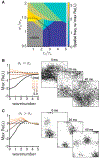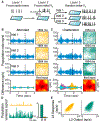Circuit Models of Low-Dimensional Shared Variability in Cortical Networks
- PMID: 30581012
- PMCID: PMC8238668
- DOI: 10.1016/j.neuron.2018.11.034
Circuit Models of Low-Dimensional Shared Variability in Cortical Networks
Abstract
Trial-to-trial variability is a reflection of the circuitry and cellular physiology that make up a neuronal network. A pervasive yet puzzling feature of cortical circuits is that despite their complex wiring, population-wide shared spiking variability is low dimensional. Previous model cortical networks cannot explain this global variability, and rather assume it is from external sources. We show that if the spatial and temporal scales of inhibitory coupling match known physiology, networks of model spiking neurons internally generate low-dimensional shared variability that captures population activity recorded in vivo. Shifting spatial attention into the receptive field of visual neurons has been shown to differentially modulate shared variability within and between brain areas. A top-down modulation of inhibitory neurons in our network provides a parsimonious mechanism for this attentional modulation. Our work provides a critical link between observed cortical circuit structure and realistic shared neuronal variability and its modulation.
Keywords: attention; cortical model; excitatory/inhibitory balance; low dimensional; neuronal variability; noise correlations.
Copyright © 2018 Elsevier Inc. All rights reserved.
Conflict of interest statement
DECLARATION OF INTERESTS
The authors declare no competing interests.
Figures







Similar articles
-
Stimulus Dependence of Correlated Variability across Cortical Areas.J Neurosci. 2016 Jul 13;36(28):7546-56. doi: 10.1523/JNEUROSCI.0504-16.2016. J Neurosci. 2016. PMID: 27413163 Free PMC article.
-
Attentional modulation of neuronal variability in circuit models of cortex.Elife. 2017 Jun 7;6:e23978. doi: 10.7554/eLife.23978. Elife. 2017. PMID: 28590902 Free PMC article.
-
Correlated variability and its attentional modulation depend on anatomical connectivity.Proc Natl Acad Sci U S A. 2024 Aug 27;121(35):e2318841121. doi: 10.1073/pnas.2318841121. Epub 2024 Aug 22. Proc Natl Acad Sci U S A. 2024. PMID: 39172780 Free PMC article.
-
Neural circuit models for computations in early visual cortex.Curr Opin Neurobiol. 2011 Oct;21(5):808-15. doi: 10.1016/j.conb.2011.07.005. Epub 2011 Aug 26. Curr Opin Neurobiol. 2011. PMID: 21873046 Review.
-
Inhibitory stabilization and cortical computation.Nat Rev Neurosci. 2021 Jan;22(1):21-37. doi: 10.1038/s41583-020-00390-z. Epub 2020 Nov 11. Nat Rev Neurosci. 2021. PMID: 33177630 Review.
Cited by
-
Large-Scale Algorithmic Search Identifies Stiff and Sloppy Dimensions in Synaptic Architectures Consistent With Murine Neocortical Wiring.Neural Comput. 2022 Nov 8;34(12):2347-2373. doi: 10.1162/neco_a_01544. Neural Comput. 2022. PMID: 36283042 Free PMC article.
-
Spatial and temporal correlations in neural networks with structured connectivity.Phys Rev Res. 2023 Jan-Mar;5(1):013005. doi: 10.1103/physrevresearch.5.013005. Epub 2023 Jan 6. Phys Rev Res. 2023. PMID: 38938692 Free PMC article.
-
Slow Drift of Neural Activity as a Signature of Impulsivity in Macaque Visual and Prefrontal Cortex.Neuron. 2020 Nov 11;108(3):551-567.e8. doi: 10.1016/j.neuron.2020.07.021. Epub 2020 Aug 17. Neuron. 2020. PMID: 32810433 Free PMC article.
-
State modulation in spatial networks with three interneuron subtypes.bioRxiv [Preprint]. 2024 Aug 24:2024.08.23.609417. doi: 10.1101/2024.08.23.609417. bioRxiv. 2024. Update in: Sci Adv. 2025 Jun 27;11(26):eads9134. doi: 10.1126/sciadv.ads9134. PMID: 39229194 Free PMC article. Updated. Preprint.
-
Intrinsic timescales in the visual cortex change with selective attention and reflect spatial connectivity.Nat Commun. 2023 Apr 3;14(1):1858. doi: 10.1038/s41467-023-37613-7. Nat Commun. 2023. PMID: 37012299 Free PMC article.
References
-
- Amit DJ, and Brunel N (1997). Model of global spontaneous activity and local structured activity during delay periods in the cerebral cortex. Cereb. Cortex 7, 237–252. - PubMed
-
- Angulo MC, Rossier J, and Audinat E (1999). Postsynaptic glutamate receptors and integrative properties of fast-spiking interneurons in the rat neocortex. J. Neurophysiol 82, 1295–1302. - PubMed
-
- Börgers C, and Kopell N (2005). Effects of noisy drive on rhythms in networks of excitatory and inhibitory neurons. Neural Comput 17, 557–608. - PubMed
Publication types
MeSH terms
Grants and funding
LinkOut - more resources
Full Text Sources

